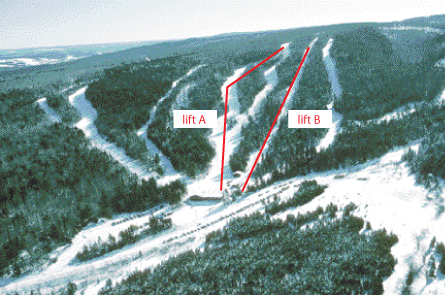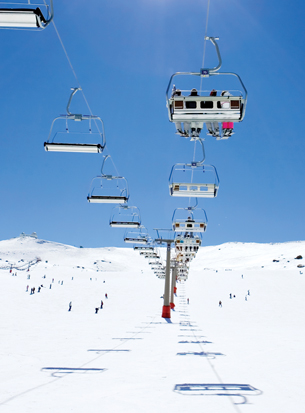Module 6—Work and Energy
 Reflect and Connect
Reflect and Connect

© 2007 Jupiterimages Corporation
There are two chairlifts in operation at the local ski hill. Both lifts move riders up the same vertical distance.
Which chairlift would be more economical to operate? Why?
Do the skiers that ride lift A have any more energy at the top than the riders on lift B?
Since lifts A and B move riders the same vertical distance, skiers (of equal mass) getting off of each chairlift will have the same mechanical energy. Therefore, in the presence of a conservative force, such as gravity, the work done to raise the skiers on both lifts will be identical and equal to their respective mechanical energies when they reach the top. Path independence exists in this situation, so both lifts would require the same amount of energy to operate.
Chairlifts, however, are not closed systems. When a non-conservative force, such as friction, is present, work must be done to overcome it. In this case, the longer path will require more work since friction must be overcome along the entire length of the path. Therefore, more work must be done to move a skier from the bottom to the top on lift A. The extra amount of work is to overcome the non-conservative force of friction. This makes lift B much more economical than lift A.
 Module 6: Lesson 3 Assignment
Module 6: Lesson 3 Assignment
Remember to submit the answer to the D 1 and D 2 to your teacher as part of your Module 6: Lesson 3 Assignment.
 Discuss
Discuss

© Nick Stubbs/shutterstock
In the discussion forum, propose an explanation for the following facts. Include a description of the energy transfers that would take place when the lift starts and stops.
D 1. If the chairlift engine fails, a brake system is required to prevent the chairlift from reversing directions.
D 2. A fully loaded chairlift, as seen here, requires more energy to start than it does to maintain its motion.
 Reflect on the Big Picture
Reflect on the Big Picture
Each of the Reflect on the Big Picture sections in this module will ask you to consider gravitational, frictional, or elastic forces. To help you consolidate your learning from this lesson, complete at least one of these reflection activities:
- Take, find, or sketch a picture of a skier on a ski lift. There are many forces acting to keep the skier from reaching the top of the ski run. Mark the picture to represent these forces. How do these forces affect the work the ski lift has to do to take the skier to the top of the run?
- Prepare a list of at least five websites that deal with the work-energy theorem. Rank the websites on the basis of how useful they would be for a beginning physics student.
Store your completed reflection in your Physics 20 course folder.
Add to the KWL chart you worked on in Module 5 and Module 6 as your Unit C Assignment. Continue to store your chart in your Physics 20 course folder.
 Module 6: Lesson 3 Assignment
Module 6: Lesson 3 Assignment
Remember to submit the Module 6: Lesson 3 Assignment to your teacher.